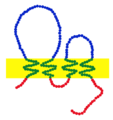
Tight junctions, also known as occluding junctions or zonulae occludentes, are multiprotein junctional complexes between epithelial cells,, sealing and preventing leakage of solutes and water. They also play a critical role maintaining the structure and permeability of endothelial cells. Tight junctions may also serve as leaky pathways by forming selective channels for small cations, anions, or water. The corresponding junctions that occur in invertebrates are septate junctions.

Occludin is a transmembrane protein that regulates the permeability of epithelial and endothelial barriers. It was first identified in epithelial cells as a 65 kDa integral plasma-membrane protein localized at the tight junctions. Together with Claudins, and zonula occludens-1 (ZO-1), occludin has been considered a staple of tight junctions, and although it was shown to regulate the formation, maintenance, and function of tight junctions, its precise mechanism of action remained elusive and most of its actions were initially attributed to conformational changes following selective phosphorylation, and its redox-sensitive dimerization. However, mounting evidence demonstrated that occludin is not only present in epithelial/endothelial cells, but is also expressed in large quantities in cells that do not have tight junctions but have very active metabolism: pericytes, neurons and astrocytes, oligodendrocytes, dendritic cells, monocytes/macrophages lymphocytes, and myocardium. Recent work, using molecular modeling, supported by biochemical and live-cell experiments in human cells demonstrated that occludin is a NADH oxidase that influences critical aspects of cell metabolism like glucose uptake, ATP production and gene expression. Furthermore, manipulation of occludin content in human cells is capable of influencing the expression of glucose transporters, and the activation of transcription factors like NFkB, and histone deacetylases like sirtuins, which proved capable of diminishing HIV replication rates in infected human macrophages under laboratory conditions.

Tight junction protein ZO-1 also known as Zonula Occludens-1 (ZO-1), is a 220-kD peripheral membrane protein that is encoded by the TJP1 gene in humans. It belongs to the family of zonula occludens proteins, which are tight junction-associated proteins and of which, ZO-1 is the first to be cloned. It was first isolated in 1986 by Stevenson and Goodenough using a monoclonal antibody raised in rodent liver to recognise a 225-kD polypeptide in whole liver homogenates and in tight junction-enriched membrane fractions. It has a role as a scaffold protein which cross-links and anchors Tight Junction (TJ) strand proteins, which are fibril-like structures within the lipid bilayer, to the actin cytoskeleton.

Claudin-1 is a protein that in humans is encoded by the CLDN1 gene. It belongs to the group of claudins.

Claudin 4, also known as CLDN4, is a protein which in humans is encoded by the CLDN4 gene. It belongs to the group of claudins.

Claudin-5 is a protein that in humans is encoded by the CLDN5 gene. It belongs to the group of claudins.

Claudin 3, also known as CLDN3, is a protein which in humans is encoded by the CLDN3 gene. It is a member of the claudin protein family.

Claudin-7 is a protein that in humans is encoded by the CLDN7 gene. It belongs to the group of claudins.

Claudin-6 is a protein that in humans is encoded by the CLDN6 gene. It belongs to the group of claudins. The knockout mice of mouse homolog exhibit no phenotype, indicating that claudin-6 is dispensable for normal development and homeostasis.

Claudin-2 is a protein that in humans is encoded by the CLDN2 gene. It belongs to the group of claudins.

Claudin-12 is a protein that in humans is encoded by the CLDN12 gene. It belongs to the group of claudins.

Claudin-8 is a protein that in humans is encoded by the CLDN8 gene. It belongs to the group of claudins.

Claudin-11 is a protein that in humans is encoded by the CLDN11 gene. It belongs to the group of claudins and was the first member of the family to be knocked out in mice, thereby demonstrating the central role of claudins for intramembranous strands observed in freeze-fracture images.

Claudin-16 is a protein that in humans is encoded by the CLDN16 gene. It belongs to the group of claudins.

Claudin-14 is a protein that in humans is encoded by the CLDN14 gene. It belongs to a related family of proteins called claudins.

Claudin-17 is a protein that in humans is encoded by the CLDN17 gene. It belongs to the group of claudins; claudins are cell-cell junction proteins that keep that maintains cell- and tissue-barrier function. It forms anion-selective paracellular channels and is localized mainly in kidney proximal tubules.

Claudin-10 is a protein that in humans is encoded by the CLDN10 gene. It belongs to the group of claudins.

Claudin-19 is a protein that in humans is encoded by the CLDN19 gene. It belongs to the group of claudins. Claudin-19 has been implicated in magnesium transport.

The intestinal epithelium is the single cell layer that forms the luminal surface (lining) of both the small and large intestine (colon) of the gastrointestinal tract. Composed of simple columnar epithelium its main functions are absorption, and secretion. Useful substances are absorbed into the body, and the entry of harmful substances is restricted. Secretions include mucins, and peptides.
Tight junction proteins are molecules situated at the tight junctions of epithelial, endothelial and myelinated cells. This multiprotein junctional complex has a regulatory function in passage of ions, water and solutes through the paracellular pathway. It can also coordinate the motion of lipids and proteins between the apical and basolateral surfaces of the plasma membrane. Thereby tight junction conducts signaling molecules, that influence the differentiation, proliferation and polarity of cells. So tight junction plays a key role in maintenance of osmotic balance and trans-cellular transport of tissue specific molecules. Nowadays is known more than 40 different proteins, that are involved in these selective TJ channels.

















